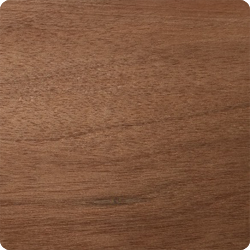Detailed Specs: Andiroba
Scientific Name: Carapa guianensis
Family: Melianceae
Other Names: Crabwood (Guyana), Cedro macho (Costa Rica), Bateo (Panama), Mazabalo (Columbia), Carapa (Venezuela), Krapa (Suriname), Figueroa, Tangare (Ecuador), Andiroba (Peru, Brazil)
The Tree
Commonly 80-100 feet in height and 2-3 feet in diameter however, it can reach up to 6 feet. Buttresses are low, leaving a clear bole length of 50 feet or more. The main stems are straight and have good form.
The Wood
General Characteristics: The heartwood varies from light salmon, reddish brown to rich red-brown when freshly sawn and becomes darker when dry. The sapwood is pinkish turning greyish, pale brown or oatmeal coloured, not always sharply defined. The texture varies from fine to coarse, luster ranges from low to high; grain usually straight but sometimes roey; odour and taste lacking.
Weight: Specific gravity (Oven dry weight/ green volume) 0.56; air dry density 41 pcf.
Drying and Shrinkage: Experience is variable, reported to air season and kiln dry slowly with a tendency to split, check and collapse, however there is no serious bowing or cupping. It is also reported to be only moderately difficult to air dry with only slight checking and warp. Kiln schedule T3-C2 is suggested for 4/4 stock T3-C1 for 8/4. Shrinkage movement in service is rated small.
Working Properties: The wood can be worked by both machine and hand tools and is reported to be somewhat harder to machine than mahogany. It has the tendency to split when nailed; it glues and screws well; peels well for veneer.
Mechanical Properties: (First set of values based on 2-in standard the second set, 1-in standard)
| Moisture Content (%) |
Bending Strength (psi) |
Modules of Elasticity (1000 psi) |
Maximum Crushing Strength (psi) |
| Green (74)
12% 12% (24) |
11,110
15,620 15,500 |
1,560
1,850 2,080 |
4,930
7,900 8,540 |
Janka side hardness 1,060 lb for green material and 1220 lb at 12% moisture and 1220 lb at 12% moisture content. Forest Products Laboratory toughness average for green and dry material is 130 in-lb (5/8 specimen).
Durability: Laboratory tests conclude that the wood is resistant to brown and white rot fungi and is reportedly resistant or poorly resistant to decay in the ground. The logs tend to be prone to attack by ambrosia (pin-hole borers) beetles, dry-wood termite and powder-post beetle attack. Weathering properties are those comparable to mahogany.
Distribution: Occurs in the West Indies from Cuba down to Trinidad and Tobago and from Honduras to South Central America, the Giuanas and into Brazil, Columbia and Peru and the overflow delta lands of the Orinoco in Venezuela. Often occurs in pure stands; a lowland species but also at high altitudes along rivers.
Preservation: Absorption is low and penetration is poor in heartwood treated by either pressure or non-pressure systems.
Uses: Suitable for all types of construction where durability is not a factor. Used for general carpentry, furniture, cabinet work, flooring, joinery, millwork, veneer, plywood and turnery.
References
– Chundnoff, Martin (1984), “Tropical Timbers of the World.” USDA Forest Service Ag. Handbook No.607.



